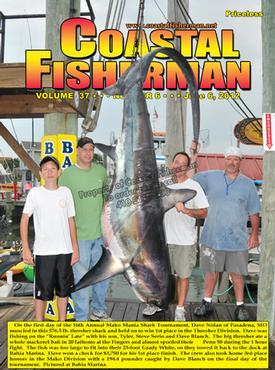


Article by Capt. Steve Whitelock
 Q: When flounder fishing in the spring, what tactics can you use if you are only able to fish the incoming tide? Where would you recommend looking for warmer water? If you do find warmer water do the fish usually bite even though it is incoming tide?
Q: When flounder fishing in the spring, what tactics can you use if you are only able to fish the incoming tide? Where would you recommend looking for warmer water? If you do find warmer water do the fish usually bite even though it is incoming tide?
Justin Fischer
Forest Hill, MD
A: In the spring, the main thing I am looking for when flounder fishing is water temperatures that are between 60 and 65-degrees. The closer to 65-degrees the better. With this in mind, fishing the end of the outgoing tide is going to give you the best chance of finding this range of water temperature because the sun has had a chance to warm the water up, hopefully close to the 65-degree mark.
However, that doesn’t mean that I will completely rule out fishing the incoming tide. Again, if I can get water temperatures up to around 65-degrees, than I like to fish the last 1/2 of the incoming tide.
We are fortunate since we can really play the tides at different locations. For example, if you want to fish the last part of the outgoing tide in the Inlet, you can do so and move to another good flounder spot later on and fish the same point in the tide. Typically, the tide in the bay behind Assateague Island near the airport runs around 2 hours later than the inlet. Up north, around the Rt. 90 Bridge it runs 3 hours later. Playing these tides can really extend your fishing day.
Playing these tides can also help you out in another area that is critical to good flounder fishing, and that is water clarity. Flounder are site feeders that ambush their prey, so having clear water is crucial. You need the fish to be able to see your bait. Sometimes, after a storm when the ocean is rough, the incoming tide will bring cloudy water into the bay, shutting down flounder fishing. However, if you can fish the tide in an area further from the inlet, where the dirty water hasn’t had a chance to reach, then you have a better chance of catching a flounder. The area north of the Rt. 90 Bridge, the flats above the Thorofare and south near the Assateague Bridge are all spots you can fish if you aren’t happy with the water clarity closer to the inlet.
In the spring, I also like to use smaller baits. Colder water temperatures make for lethargic fish and I feel that flounder will go after a smaller bait than the larger ones we fish with in the summer. Minnows or the Gulp! Alive Swimming Mullets are both good baits to use in the spring. This year, the white Swimming Mullets are working well, which is odd since red is usually my go-to color in the spring.
During the summer, when the water can really get warm in our bays, our tactics change. That time of year, the cooler water being brought in from the ocean makes the incoming tide the preferred time to flounder fish. But again, having clean water is key, and is probably more important than water temperature during the summer months.
When we are flounder fishing in late July and throughout August, I like to find deeper holes in the bay where the water temperature will be cooler. I also like to drift the edges of the channels working my baits from the shallow water into the deeper holes. This time of year, we can also fish larger baits such as spot, squid, shiners, cut bluefish and tuna.
When it comes to water temperature in the summer, one of the things we sometimes see occurs when we have a consistent south wind. This causes a phenomenon that is known as upwelling, where the wind drives the deeper cooler water to the surface, replacing the warmer surface water. This can cause a shutdown in our flounder fishing.
Justin, I hope this answers your questions. Just remember that water temperature and clarity are the keys when fishing for flounder. Focus on water temperatures in the spring and water clarity during the summer.
On a side note, we have a lot of boats fishing for flounder in our bays and common courtesy can play a role in the amount of fun we all have on the water and the number of fish we catch. If you pull up on a spot and everyone is drifting in one direction, don’t keep your boat in one spot by bumping your motor in and out of gear. Drift in line with all of the other boats. It makes for a better day for everyone.
Do you have a question for a local pro? Email your question to [email protected]. Don’t forget to include your name, town and phone number.